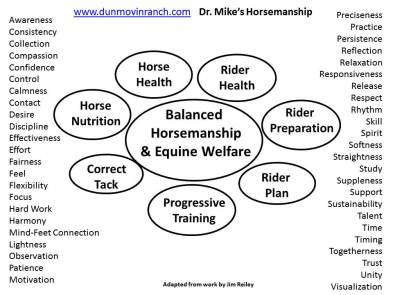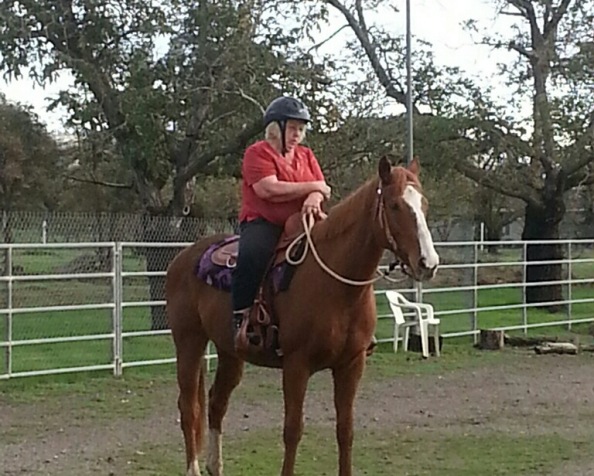Balance, Self-Carriage, and Collection – it is a journey
by Dr. Mike Guerini (www.dunmovinranch.com)
When I show up to give a lesson or teach a clinic, riders often ask me what my secret is too getting collection. Many times people call me and ask if I can come and help them get their horse collected better. After about 2 minutes on the phone – much of the time the person tells me they just want better collection and do not think they need to work on balance and self-carriage. There are times when I hear – well what bit do you use to get collection?
I know that I often frustrate folks when I tell them that to achieve collection…it is long hours of proper development of horse and rider … in terms of muscle and timing (and a great many other things) … to develop collection. I go on to tell them that collection comes after we learn and achieve balance and progress into self-carriage. I also tell folks that no bit and no amount of pull by the riders hands is ever the answer to collection.
Balance is the ability to move or to remain in a position without losing control or falling and it is a state in which different things occur in equal or proper amounts or have an equal or proper amount of importance.
Self-Carriage is defined as a time when the horse is balanced (has independent balance as stated by Manolo Mendez) and self-maintains his own rhythm, tempo, stride length, straightness, outline and rein and leg contact and engagement. The horse still needs guidance from hands and legs and core and seat of the rider — but the horse is taking care of balance to them be able to work in a dynamic way.
Just a quick side note — see how self-carriage relies on balance?
Collection Collection occurs when a horse carries more weight on the hind legs than the front legs. The horse draws its body together so that it becomes like a giant spring whose stored energy can be reclaimed for fighting or running from a predator. The largest organic spring in the horse’s body, and therefore the easiest one to observe in action, is the back, including the spine and the associated musculature that draws it together in much the same way that a bow is drawn by an archer. (Collection can only come from a horse allowed and able to move freely – having learned to carry himself through training which lets him develop his own balance and rhythm. – March 24, 2014 by Caroline Larrouilh in an article written and published on the Manolo Mendez website).
So let us get to the point. I have stated that no amount of pull of the hands, size or type of bit, or even one or two lessons will ever get you perfect collection. It takes development of balance, which in turn leads to self-carriage that finally allows you to work on the finesse of aids and timing that will help you and your horse achieve collection.
Here are five exercises that I highly recommend you master on your journey to collection. There will be days in which you are excellent in your mastery of these activities…and other days will not be as great…but it is the dedication to the work and development of the horse that will ultimately lead you to success.
Exercise #1: Learn the footfalls of your horse. Quite simply, from the ground or when you are in the saddle. Be able to call out what each foot is doing at any time in the rhythm of the movement of the horse.
Exercise #2: Learn to direct the footfalls of the horse. Once you know where the footfall is, then you can begin to direct it to change time in flight and landing placement. This ability will help you with developing the rear engagement of your horse that you will need to achieve before we get to collection.
As you do these two above exercises, in the first you are developing yourself as a rider. In the second, you are developing yourself and your horse to work in harmony and partnership.
Exercise #3: Learn to do the first two exercises without the use of stirrups. You need to make certain that as a rider you can feel the horse and work with the horse and not have your balance compromised by using your stirrups as a crutch. You need to be able to balance with your whole body on the back of the horse. You also need to be able to post without your stirrups and achieve the goals of exercise 1 and 2 above (and yes for all the western riders – posting is encouraged at times). You cannot be heavy on your seat bones…you cannot be heavy on your legs…you cannot be heavy with your thighs. You must be balanced. (Just the other day Mark Russell said the rider needed to be like a champagne bubble riding on the back of the horse – yes that would be a nice picture of a balanced champagne bubble that did not have the rider leaning on seat or legs or feet or thighs…but rather, the rider would be in a perfect state of harmony and balance on the back of the horse).
Exercise #4: Do the above three exercises with the lightest amount of contact…and occasionally, release any of your contact and determine if your horse maintains the rhythm and tempo. This exercise begins to tie in a measure of how much self-carriage you are achieving…and remember that self-carriage comes when you have balance.
Exercise #5: Learn to do the first four exercises while working over ground poles and cavaletti’s. This simply adds a degree of difficulty that requires the rider to focus on balance, movement of the horse and changes in terrain (poles or cavaletti’s) that put the horse and rider into thinking mode.
Most importantly in all of the above – you must remember to breathe through all that work.
Once you have mastered those five activities … then you and your horse are ready to begin work on the exercises that will ultimately lead to collection.
Please feel free to share this blog.
—————————-
Dr. Mike Guerini is a national clinician, author of multiple Horsemanship books, co-inventor of the Equine Hydro-T and specializes in DR 4 Balance – to help horse and rider acheive goals. Dr. Mike works with riders to enhance their performance based riding, Western Dressage and understanding and welfare and rehabilitation of the horse and you can learn more about Dr. Mike and his 6 C’s of Horsemanship at www.dunmovinranch.com. Dr. Mike is also part of Coach’s Corral (www.coachscorral.com), an online Horsemanship Coaching program for competitors.



